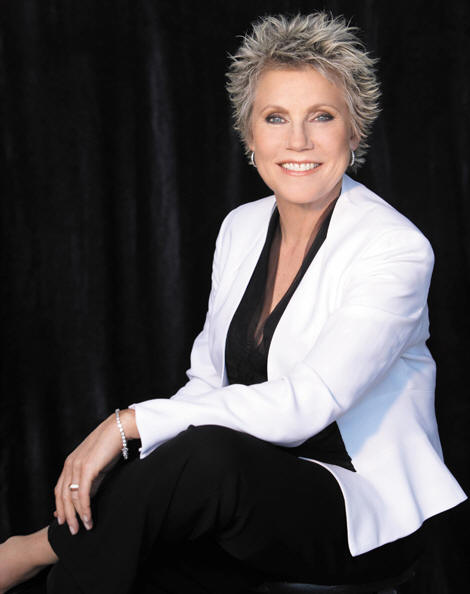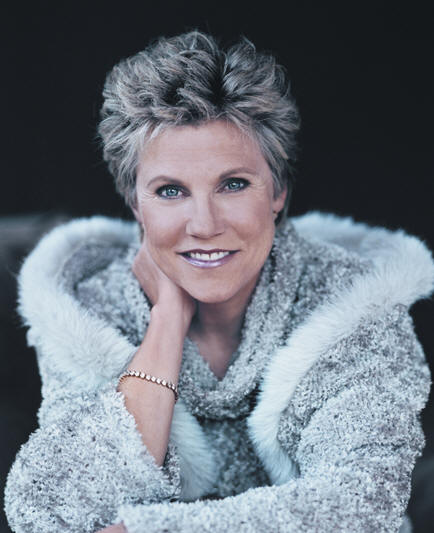Anne Murray keeps
making the same mistake. She thinks her recording career is over. She
thinks the awards are long gone. She thinks the charts are out of
reach. Fortunately for all of us, she’s wrong on all counts.
Murray is in the
midst of a 56-show tour. Her current release Anne Murray Duets:
Friends & Legends hit #8 on Billboard’s Country Chart and is
nominated for two Canadian Juno Awards, including Album of the Year
(Murray has 24 Junos and four Grammys). “The last time I had anything to
do with the Junos,” recalls Murray, “I was inducted into the Hall of
Fame in 1992. That was sixteen years ago. I’m sure all of these kids
thought they’d seen the last of me.”
They can think
again. Possessed of a warm alto with some of the purest tones ever
recorded and an uncanny ear for choosing mature songs, Anne Murray has
amassed a vast catalogue of music spanning pop, country and folk. Some
of her biggest hits — “You Needed Me,” “Shadows in the Moonlight,”
“Songbird,” “Nobody Loves Me Like You Do” — are instantly recognizable
melodies to many world citizens. Many have been re-recorded on her new
Duets CD with a roster of women luminaries, including Olivia
Newton-John, Celine Dion, the Indigo Girls, Carole King and Shania
Twain.
“It’s never been a
high profile career,” reflects Murray. “I’ve never done the celebrity
thing — I just do what I do. I have found that my career has just been
about the folks and me. It’s kind of a love affair between us, as
opposed to the hype of playing the bigger cities and having to go
through all of that.”
One of Murray’s
great charms is her unassuming nature, matched by a surprisingly sharp
wit and a modest sense of her own talent. Born in Springhill, Nova
Scotia, Murray was nine years old, riding in her parents’ car and
singing when her Aunt Kay — whom she now wryly refers to as “tone deaf”
— commented: “My, she has a lovely voice.”
“Perhaps that’s
the moment I began to define myself as a singer,” observes Murray.
“When I got to university, my friends kept pushing me to audition for
the college review. I said, ‘There are lots of people out there who are
better than I am.’”
Once she started
to attend those reviews, however, Murray had an epiphany. “I’d go to
these things and I’d think, Holy God, why didn’t you do that? These
people aren’t nearly as good as you,” she now laughs. “Even when I
auditioned for a television show in my second year at university, I
thought, ‘Oh, I don’t have a chance.’ Well, I was better than anybody
there — and there were hundreds of people! I knew I was, but maybe a
part of me still didn’t believe it.”
 The
richness of Murray’s sound became evident early on: She describes her
voice as ”fat, round and warm — and different than anybody else’s.” Her
timing could not have been better. She entered the music scene when
folk elements still dominated popular music, and the clarity of her tone
and her incredible pitch were a perfect fit.
The
richness of Murray’s sound became evident early on: She describes her
voice as ”fat, round and warm — and different than anybody else’s.” Her
timing could not have been better. She entered the music scene when
folk elements still dominated popular music, and the clarity of her tone
and her incredible pitch were a perfect fit.
From the inception
of her career, her voice was undeniably suited for ballads. “I think
interpretation is everything,” explains Murray in retrospect. “The way
I look at it, I get in the studio and I become one with these songs. But
it has to touch me. If it doesn’t, then I can’t hope to touch anyone
else. I have to be completely sucked in by the song. At least that’s
the way I think of it. It sounds complicated, but it isn’t really.”
While most of the
focus has been on Murray’s more popular numbers, almost four decades of
recorded music disclose her finely tuned sense of song choice. An early
song such as “You Can’t Have A Hand on Me,” from 1972’s Annie,
hints at an edgier side to Murray’s voice, with its darker gospel
elements. That sound would resurface in such later numbers as “Lay Me
Down (And Roll Me Out to Sea)” and “Take This Heart.”
“Mahalia Jackson
was a great influence on me,” notes Murray of the gospel influence on
some of her music. “I had every one of her albums when I was a kid, and
we played them in the house all the time.”
Murray holds a
soft spot in her heart for another early number, “A Million More,” from
her 1976 album Keeping in Touch. “I think that song could have
been the biggest record ever if the lyrics were a little clearer,” she
says of the pensive number, written by her first guitar player Robbie
MacNeill. “A lot of people have to be hammered over the head with
lyrics,” she explains. “So, they have to be a little clearer — not quite
so abstruse. If you really think about those lyrics, you understand
exactly what they mean.”
During her long
career, Murray has rolled the dice a number of times with Kenny Loggins
songs and experienced huge success with “Danny’s Song” and “A Love
Song.” Both are reprised on the new Duets album, with Martina
McBride joining Murray on “Danny’s Song” and k.d. lang lending her muted
tones to “A Love Song.” One of Murray’s finest artistic moments came in
1983 when she recorded another Loggins tune, “The More We Try,” a
haunting and exquisitely crafted ballad. “I love that song,” she
admits, “and it was a great performance.”
 A
song like “The More We Try” also illustrates Murray’s moving ability to
express emotion subtly. She is the antithesis of the psychotic
over-singing that characterizes much of today’s pop music.
A
song like “The More We Try” also illustrates Murray’s moving ability to
express emotion subtly. She is the antithesis of the psychotic
over-singing that characterizes much of today’s pop music.
“I do think
there’s over-singing going on because I don’t believe one word I’m
hearing,” she comments. “With all those gymnastics occurring, I don’t
know what the melody is. The song disappears — it’s just plain showing
off. That kind of stuff is great used in moderation.” Murray adds, “If
you grow up listening to all those licks and you’re vocally adept, you
can do it. It’s just not part of who I am.”
At the Grammy
Awards in 1974, John Lennon stepped into Murray’s dressing room to tell
her that her rollicking version of “You Won’t See Me” was the best cover
of a Beatles song he had heard. She was speechless. She met Lennon
once more — at the Troubadour in Los Angeles, with Harry Nilsson, Alice
Cooper and Mickey Dolenz. A picture of the five of them together
reveals a demure Murray surrounded by what she has jokingly referred to
as “a bunch of reprobates.”
In 1993 Murray
recorded a milestone in her career with Croonin’, an album of pop
standards mostly made famous in the 1950s. The songs fit her voice like
a glove as she channeled her inner Patti Page and Rosemary Clooney. “I
should have been born in that era,” says Murray, “because my voice is so
well-suited to those songs. Croonin’ is one of my finest. The
‘50s were my childhood. I was weaned on these songs and grew up singing
them. That album is the most honest thing I’ve recorded in my life.”
Unbelievably,
Murray first recorded the album without a label and then sold it to EMI
Canada, where it was a great success. “Unfortunately it did nothing in
the US,” she laments, “because the record company was not a part of
it.” A record executive told Murray he would not promote it because he
“didn’t have anything to do with it.” Lauded by critics, it remains a
fan favorite.
One of the stellar
moments on Murray’s new CD is a “duet” with the late Dusty Springfield,
who was a close friend. Springfield had also recorded “I Just Fall In
Love Again” (in the same year as Murray — 1979), and Murray asked the
late singer’s estate for permission to use the vocal from that track.
 “She
recorded it in a booth, so there was isolation,” observes Murray. That
isolation allowed Murray and her producer, Phil Ramone, to “lift”
Springfield’s vocal and drop it into the new arrangement. “It sounds
like the real thing,” says Murray. The two singers’ voices create a
heavenly blend, one of the most effective on the album.
“She
recorded it in a booth, so there was isolation,” observes Murray. That
isolation allowed Murray and her producer, Phil Ramone, to “lift”
Springfield’s vocal and drop it into the new arrangement. “It sounds
like the real thing,” says Murray. The two singers’ voices create a
heavenly blend, one of the most effective on the album.
“It was very eerie
to do it,” Murray admits, “because I had worked with her on a few
occasions and we were friends.”
Although Murray
has become renowned for her more melancholic numbers, she says they pose
a challenge in her live act: “Even ‘Somebody’s Always Saying Good-Bye,’
which is one of my favorite performances on record, when I do that live
I have to pull people back. It’s like ‘Broken-Hearted Me,’ one of my
biggest records. You have to pull them out of a hole after you sing
that song. I can’t leave a crowd like that. You have to leave them
smiling. Those are beautiful songs. But, ‘Broken Hearted Me’ — I have
to even pull myself up by the shoelaces after that one!”
Still, it’s those
go-home-and-drink-the-bleach songs that truly reveal the depth of
Murray’s glorious talent. For more than 35 years her achingly honest
voice has reflected the hopes and longings most people experience in a
lifetime. Commenting on the emotional power of tunes like Jesse
Winchester’s evocative “Wintry Feeling,” Murray says: “There are some
songs that do that. That song has always moved me — really moved me —
even now when I sing it. And ‘Song for the Mira’ is another one. When
I sing that I get choked up, too.”
And that’s why
Anne Murray can just forget about retiring: Every now and then, we all
still need to get a little choked up.